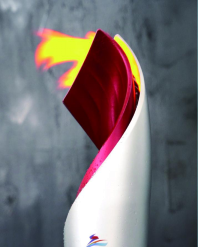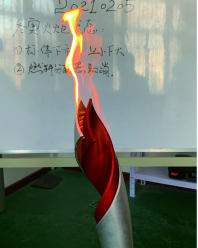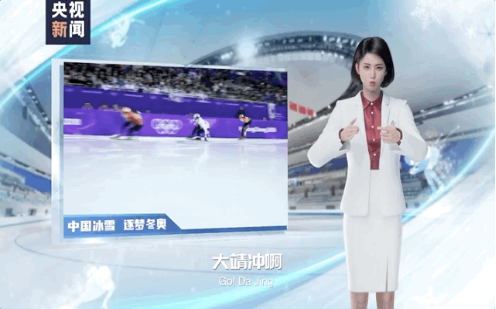Beijing 2022 High-tech Winter Olympics
In the organization of the Beijing Winter Olympic Winter Games, there is one area that is closely related to people’s lives, i.e. high-tech Winter Olympics. It is a concept that has been practiced in every aspect of the Beijing Olympic Winter Games, from infrastructure construction, event organization and venue operation to viewer experience and COVID containment. 5G, cloud computing, big data, satellite navigation, artificial intelligence...come and feel the power of technological innovation at the Winter Olympics.
1.Hydrogen-fueled handheld torch for the Winter Olympics - zero carbon emission & high stability


Using hydrogen as the fuel, the handheld torch produces zero carbon emission. This Olympic handheld torch has adopted the high-pressure hydrogen storage solution, and its combustion system has solved the problems of visibility of hydrogen flames, adaptability of complex curve surfaces, large scale decompression, and safe utilization of hydrogen, which makes it more adaptable to the environment. It has been tested and proven to be able to burn stably and reliably in harsh environments such as strong wind, heavy rain, low temperature, and high altitude. The Winter Olympic torch relay has helped spread the concept of hydrogen utilization far and wide.
2.100% green electricity supply
The preparations for the Beijing Winter Olympic Games, which are closely integrated with the development of the city and the region, have helped improve the region’s ecological environment, and boost socioeconomic development. During the Beijing Olympic Winter Games, all the 26 venues in the three major competition zones are fully powered by “green electricity”, which means 100% green electricity for all competition venues for the first time in the Olympic history.
3.Innovation of 5G-enabled, intelligent vehicle networking system

The 5G-enabled, intelligent vehicle networking system is in full application in Winter Olympic Parks. With the innovation of 5G + C-V2X fusion networking, network transmission delay is reduced to less than 10 milliseconds. Multi-source fusion and high-precision positioning based on 5G + BeiDou can satisfy the demand for continuous indoor and outdoor high-precision vehicle positioning at the 0.1 meter level. The L4 autonomous driving technology based on road-side all-area perception overcomes the limitations of narrow sight range and high cost caused by the dependence on vehicle body, which accelerates the development of the automotive industry and give rise to new business models.
4.Reliable 5G communication network in complex and extreme environments
The new 5G base station adapted to high altitude, high wind speed, high coldness and other harsh natural conditions has been providing stable live services for a year at an altitude of over 5,000 meters in the Mount Qomolangma (Mount Everest), achieving 5G communication under extreme natural conditions. The 200 megahertz large-bandwidth outdoor base station and the 300 megahertz ultra-large-bandwidth indoor base station equipment are able to meet the demands for large-bandwidth and high-capacity services during the Winter Olympics. They have been fully tested in the test tournament, and are able to provide safe, stable and reliable services for a long time, offering a potential solution for the construction of 5G networks in subsequent extreme scenarios.
5.Interactive, multi-dimensional game-watching experience technologies and systems
Considering the special features of the ice and snow sports, homegrown 8K + VR live streaming system and 6DoF VR technology are be used in the demonstrative broadcasting of the Winter Olympics events. The viewers can watch VR live broadcasting through their cell phones, VR headsets and TV screens, overcoming the limitations of fixed perspective and passive viewing in traditional broadcasting and revolutionizing the user viewing experience. The project has given a boost to the development of ultra-high-definition VR content and the industry of VR display equipment and promoted the application of 5G technology. It has brought in more people to watch the games, add a new technological element to the Winter Olympics, and inject new impetus to the Winter Olympics economy.
6.Ultra HD 8K digital broadcasting technology and system
The innovative 5G + 8K portable transmission system, which combines the 5G + 8K ultra HD transmission system with the ultra-high bandwidth of 5G network, provides 8K ultra HD video broadcast-quality coding transmission. Through the built-in 5G module multi-channel bandwidth intelligent data allocation, multi-channel data aggregation and other technologies, the system ensures 8K ultra HD video transmission in the 5G network with high stability, high reliability and high quality in a single-cameraman backpack scenario.
7.Professional and accurate AI sign language interpretation

AI sign language anchor can not only report news, but also conduct live sign language broadcast of the events. This has helped hearing-impaired persons enjoy the exciting events of the Winter Olympics. The AI anchor is a sign language translation engine and natural motion engine driven by voice recognition and natural speech comprehension technologies, with the ability to express in sign languages. With professional and accurate sign language commentary, “she” can present the “speed” and “passion” of the Winter Olympic to the audience.
8.Athlete technical movement acquisition - feedback - optimized application demonstration
Biomechanical fast feedback system for ski jumping. Setting up multiple high-speed, high-definition cameras to collect 3D motion data, and using artificial intelligence-based image recognition technology to automatically identify the location of each joint point of the athlete, and calculate the jumping stirrup distance, jumping joint angle, jumping vertical speed and other important indicators to realize 3D motion capture and analysis. BeiDou-enabled digital snow field feedback system. Using the BeiDou navigation system to digitize venue information and athletes’ skating trajectory, and get feedback on the height of jump, take-off speed, angle of jump, position movement, data comparison and other information.
9.Collection of aerosol samples
During the Winter Olympics, aerosol samples are collected at each competition venue, and then transferred to the testing station for testing. The results are reported to the epidemic control departments within 4 hours to assist them in taking further measures based on the results.
Source: Ministry of Science and Technology, P.R.China